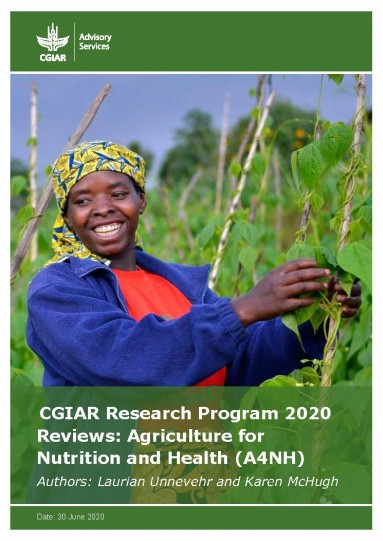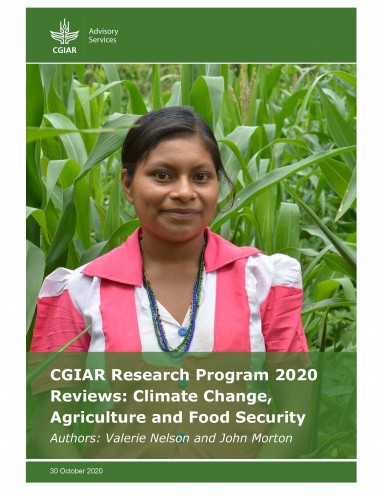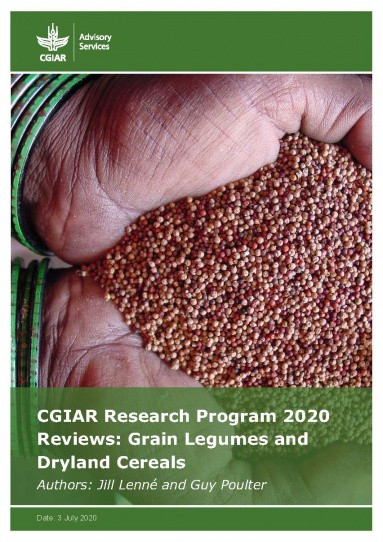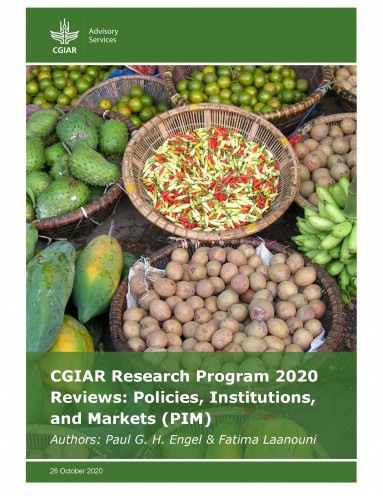- This review does not intend to be full programmatic evaluations, which cover more criteria and require a larger investment. Instead, these reviews provide value for money for CGIAR in terms of asking pertinent questions to independent experts in order to fulfill a key responsibility of CRPs, to demonstrate accountability to system funders.
- The CRP Review team is working in close coordination with the CGIAR SMO (System Management Office, hosted in Montpellier, France) Programs Unit and will be liaising through the Independent Science for Development Council (ISDC) Chair, in his capacity as a member of the Research Transition Advisory Group, to align with any opportunities to bring information into the One CGIAR research modality conversations.
Authors: Laurian Unnevehr and Karen McHugh, June 2020. 56 pages
- A4NH focuses on the potential for agriculture to significantly improve nutrition and health. It began Phase I in 2012, led by IFPRI with nine other participating CGIAR Centers.
- In Phase II (2017–2021), A4NH continues to be led by IFPRI and is now managed by a group of four other CGIAR Centers (CIAT, Bioversity, ILRI, IITA) and two academic institutions (WUR, LSHTM).
- Research activities are carried out through five flagship programs (FPs): FP1–Food Systems for Healthier Diets; FP2–Biofortification; FP3–Food Safety; FP4–Supporting Policies, Programs, and Enabling Action through Research (SPEAR); and FP5–Improving Human Health. Two of these flagships, FP1 and FP5, are new in Phase II.
Authors: Valerie Nelson and John Morton. 30 October 2020. 46 pages
CCAFS is one of four cross-cutting Global Integrating Programs within the CGIAR portfolio. - It seeks to address challenges of climate change and food security by mobilizing CGIAR and partner science and expertise to achieve positive change with respect to climate-smart agriculture (CSA), food systems, and landscapes.
- Phase II (2017–20) builds on Phase I (2011–16). CCAFS is a partnership of 15 CGIAR Centers, led by the Alliance of Bioversity International and the International Center for Tropical Agriculture (CIAT) (hereafter referred to as ‘the Alliance’), with 27 non-CGIAR strategic partners.
- Research activities are carried out through four Flagship Programs (FPs) and two cross-cutting Learning Platforms (LPs). The FPs/LPs are as follows: FP1–Policies and Priorities for CSA; FP2–Climate-Smart Technologies and Practices; FP3–Low-Emissions Development; FP4–Climate Services and Safety Nets; LP5–Gender and Social Inclusion; and LP6–Scaling Climate Smart-Agriculture.
Authors: Jill Lenné and Guy Poulter July 2020. 46 pages
The main objective of the CGIAR Research Program Grain Legumes and Dryland Cereals (GLDC) is to increase the productivity, profitability, resilience, and marketability of nutritious grain legumes (chickpea, cowpea, pigeonpea, groundnut, lentil, soybean) and cereals (sorghum, pearl millet, finger millet) grown in semi-arid and sub-humid dryland agroecologies of Sub-Saharan Africa and South Asia.
- GLDC is led by ICRISAT in partnership with IITA, ICARDA, ICRAF, ILRI, Bioversity International, CIAT, IRD, CIRAD, CSIRO, and many nongovernmental organizations (NGOs), national agricultural research systems (NARSs), and private sector partners.
- It is structured on five flagship programs (FPs): FP1: Priority Setting and Impact Acceleration; FP2: Transforming Agri-food Systems (not funded); FP3: Integrated Farm and Household Management; FP4: Variety and Hybrid Development; and FP5: Pre-breeding and Trait Discovery. FP6: Common Bean was incorporated in 2019 and approved by the CGIAR System Management Office (SMO) in 2020.
Authors: Karen McHugh and Ben Bennett. 26 October 2020. 42 pages
The goal of the Livestock CRP is to create a well-nourished, equitable, and environmentally healthy world through livestock research for development.
The goal of the Livestock CRP is to create a well-nourished, equitable, and environmentally healthy world through livestock research for development.
- It builds on the previous Livestock and Fish CRP aiming to increase the productivity of livestock agri-food systems in sustainable ways, making meat, milk, and eggs more available and affordable across the developing world.
- The CRP is carried out through five Flagship Programs (FPs): Livestock Genetics (FP1); Livestock Health (FP2); Livestock Feeds & Forages (FP3); Livestock & Environment (FP4); Livestock Livelihoods & Agrifood Systems (FP5), and through the cross-cutting themes of Gender and Capacity Development.
- The Livestock CRP review was an opportunity to generate insights about quality of science (QoS), effectiveness, and future orientation, addressing three questions. It covers activities from 2017 to 2019 and was conducted from August to October 2020.
- PIM uses four main channels to address these constraints: global agenda setting, national policy support, program and market innovations, and capacity development. PIM projects are implemented in Africa South of the Sahara, South Asia, and selected countries in the Middle East and North Africa, East Asia, Southeast Asia, and Latin America.
- Led by the International Food Policy Research Institute (IFPRI), PIM brings together all CGIAR Centers and national, regional, and international partners. External managing partners include Royal Tropical Institute (KIT), Michigan State University, University of Oxford, Wageningen University, and World Vision International.
- The PIM budget for 2019 is estimated at US$56 million. Research activities are carried out through six flagship programs (FPs): FP1 – Technological Innovation and Sustainable Intensification; FP2 – Economywide Factors Affecting Agricultural Growth and Rural Transformation; FP3 – Inclusive and Efficient Value Chains; FP4 – Social Protection for Agriculture and Resilience; FP5 – Governance of Natural Resources; and FP6 – Cross-cutting Gender Research and Coordination.
WHEAT
Authors: Victor Sadras, Donna Podems. July 2020. 50 pages
Authors: Victor Sadras, Donna Podems. July 2020. 50 pages
The review’s purposes are to assess to what extent WHEAT is (1) delivering quality of science, and (2) demonstrating effectiveness in relation to its own Theories of Change (ToC). The third purpose is to provide insights and lessons to inform the program’s future.
- The review was designed to deliver top-level findings proportional to the desk-top work of two reviewers for 11 weeks.
- The primary audience is the CGIAR System Council. Other audiences may find the review useful, such as WHEAT managers and scientists, their partners and other CGIAR Research Centers and CRPs.
- FISH
- Forests, Trees and Agroforestry
- MAIZE
- RICE
- Roots, Tubers and Bananas
- Water, Land and Ecosystems







No comments:
Post a Comment